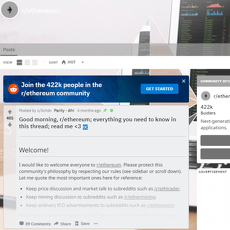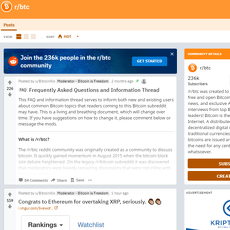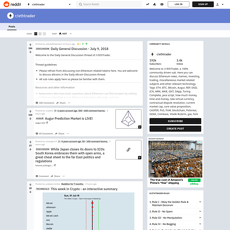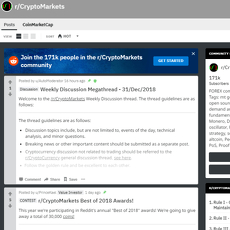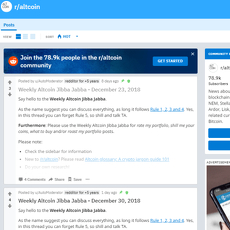r/LitecoinTraders Review
r/LitecoinTraders
www.reddit.com
r/LitecoinTraders Review Guide: Everything You Need to Know + FAQ
Are you checking r/LitecoinTraders hoping for an edge… or just getting pulled into noise and FOMO threads that add nothing to your trades?
If you want to trade LTC smarter—not louder—this is your playbook. Think of the subreddit as a tool. Use it right, and you’ll spot sentiment shifts early, collect fresh TA perspectives, and pressure-test your ideas. Use it wrong, and you’ll scroll for an hour, catch three “guaranteed” calls, and wonder why your PnL looks like a roller coaster.
The problem most traders face on Reddit
Reddit can be a goldmine or a trap. On trading subs, two issues show up again and again:
- Too much noise: Hype posts, one-liners, and cherry-picked wins drown out thoughtful analysis.
- Too little context: Calls without invalidation, no timeframes, and no risk discussion make it impossible to evaluate.
What noise looks like:
“LTC to the moon tomorrow” — no chart, no levels, just vibes.
What signal looks like:
“4H LTC: resistance at $78–80, support $71; invalidation below $69 close. RR 2:1 toward $86. Watching hash rate uptick + BTC dominance dip.”
Worse, the culture can shift with the market. When price rips, you’ll see victory laps and high-leverage flexes. When it dumps, there’s panic, doom charts, and “last chance to get out” energy. If you don’t have a way to filter fast, you’ll absorb the mood—and trade it.
Social sentiment does matter in crypto (multiple industry analyses have shown short-term correlations between attention spikes and volatility), but raw hype isn’t a strategy. You need a way to turn crowd chatter into structured input.
What you’ll get out of this
Here’s what I’ll show you, step by step:
- What this subreddit is actually useful for (and what to ignore).
- How to set up a quick filtering workflow so your feed turns into research, not distraction.
- How to spot quality posts in seconds, using simple criteria you can reuse every session.
- How to stay safe from DMs, funnels, and “VIP” promises that go nowhere.
- A simple checklist you can keep open while browsing.
Who this is for
- Active LTC traders who want faster sentiment reads and extra angles on key levels.
- Swing traders who need context without getting pulled into intraday noise.
- Beginners who want to learn how traders think—risk, timeframes, invalidation—without copying random calls.
Quick verdict upfront
r/LitecoinTraders can be helpful for real-time sentiment, TA viewpoints, and market checkpoints—if you filter aggressively, ignore unverified calls, and stick to your plan. Treat it like a research feed, not a signal service.
Want a concrete example? If you see a post claiming “LTC to $100 by Friday,” here’s the fast filter I use:
- Timeframe? 1H, 4H, Daily—if it’s missing, skip.
- Levels? Clear support/resistance or ranges, not just arrows.
- Invalidation? “I’m wrong if we close below X.” No invalidation = entertainment, not analysis.
- Reasoning? Even two lines: LTC/BTC pair, hash rate, funding, open interest, or on-chain metrics. Any one is fine if it’s coherent.
- History? A quick user check: do they post consistently, or only when something “moons”?
Most posts fail one of those tests. That’s fine. You’re not hunting perfection—you’re filtering for signal. And once you know how the sub is set up and who typically posts what, this becomes second nature.
Curious what kind of content actually lives on this subreddit, who hangs out there, and how the rules shape the vibe when the market is hot vs. cold? Let’s break that down next so you can decide exactly how (and when) to use it without wasting a minute.
What is r/LitecoinTraders? The basics and why it exists
r/LitecoinTraders is a Reddit community built for one specific job: talk Litecoin price action like traders, not tourists. It’s where people post charts, compare levels, argue over scenarios, and sanity-check the next move on LTC without getting pulled into every other coin’s noise.
Who hangs out here? You’ll mostly see swing traders, intraday chart-watchers, and a handful of fundamentals-first people who still respect the chart. The focus is narrow by design. This isn’t a general crypto chatroom or a place for wallet help—think LTC pairs, key zones, catalysts that actually move price, and battle-tested trading habits.
Why it exists is simple: Litecoin trades differently enough from Bitcoin and the large caps that a dedicated stream helps. Correlation is real, but timing and structure often have their own rhythm. A focused subreddit gives you a faster read on crowd positioning, stronger context during halving talk or hash rate shifts, and a clearer lane to compare trade plans without the altcoin-of-the-day distraction.
“In markets, clarity beats certainty. You won’t know for sure—but you’ll know what to look for.”
That’s the heartbeat of r/LitecoinTraders: don’t promise outcomes, map scenarios.
Subreddit at a glance
Here’s what you’ll actually see when you scroll the feed:
- Technical analysis posts — Screenshots from TradingView with marked levels, trendlines, and notes like “4H structure,” “D1 support,” “LTC/BTC confluence.” Good posts call out invalidation and exact zones.
- Trade ideas — Simple setups such as “Break-and-retest at X,” “Range play between Y and Z,” or “Momentum continuation if MAs hold.” The better ones include timeframe and risk.
- Questions and check-ins — “Is LTC tracking BTC dominance?” “Does LTC react differently around CME gaps?” “Anyone watching the weekly pivot?” These often pull helpful replies if you share your chart.
- News reactions and catalysts — Threads around halving timing, network metrics, fee changes, or macro headlines that could impact liquidity and sentiment.
- Sentiment threads — Pulse checks like, “Are we still ranging?” or “Capitulation or boredom?” Useful for context, not for orders.
Posting tempo swings with volatility. During quiet ranges, you’ll see a handful of fresh charts each day and some check-ins. During big moves, expect a flood: quick updates, level-by-level commentary, and “here’s where I’m wrong” posts from the sharper voices. Quality is mixed (it’s Reddit), but there are recurring contributors who consistently label levels, share invalidation, and update their viewpoint when price action changes. Those are the accounts you’ll want to save.
If you’re wondering whether any of this chatter actually matters, attention data and market behavior do connect. Research has shown that online message-board activity and search volume can correlate with short-term volatility and momentum in traditional markets and crypto alike (e.g., Antweiler & Frank, 2004; Da, Engelberg & Gao, 2011; Kristoufek, 2013). Translation: community activity won’t pick your entries, but it can help you spot when the crowd is leaning, when risk is building, and when to tighten up.
Examples you’ll likely bump into:
- “LTC 4H: ascending triangle under resistance with wicks rejecting; invalidation above today’s high; targeting prior range mid if the base cracks.”
- “LTC/BTC weekly looks heavy while BTC.D rises—be careful extrapolating USD strength without checking the pair.”
- “Halving thread: price tends to move earlier than headlines; my plan is to trade levels, not dates—sharing zones on D1.”
Rules, tone, and culture
Every good trading sub needs guardrails. Expect variations of these norms:
- No spam or paid shills — Referral links, copy-trading ads, and “VIP signal” funnels usually get nuked.
- Source your claims — If you cite on-chain stats, open interest, or funding, link the source or show the screenshot and timeframe.
- No unsolicited DMs — Pitching strangers in private is a fast way to catch a ban and a report.
- Charts need context — Timeframe, levels, invalidation. If it’s a pretty picture with no plan, it won’t fly for long.
The tone swings with price:
- When markets rip — You’ll feel the euphoria. People post breakout targets, victory laps, and aggressive projections. This is when overconfidence creeps in. The best posts still show “where I’m wrong.”
- When markets bleed — More stoic TA, more questions, and a few doom posts. Patience returns, and so does the value of clean daily/weekly levels. Good threads get calmer.
Culturally, straightforward wins. If you ask, “Should I buy now?” you’ll get noise. If you post, “Here’s my LTC plan on the 4H: entry X, stop Y, invalidation Z—am I missing anything?” you’ll get useful feedback. Specifics earn respect.
How it stacks up against other Litecoin and trading subs
Think of r/LitecoinTraders as your LTC-specific terminal tab. It’s not trying to be Reddit’s everything feed—it’s the place you go when you want Litecoin price talk without detours.
- r/LitecoinTraders vs. r/litecoin — r/litecoin is broader: network updates, adoption stories, wallet tips, dev news. Great for staying informed, but trading threads are diluted. When you want structured TA and levels, the traders’ sub is cleaner.
- r/LitecoinTraders vs. r/CryptoMarkets or r/CryptoCurrency — The big rooms are better for macro context, cross-asset flows, and news avalanches. Use them when you want to understand the wider market. Come back to r/LitecoinTraders to translate that context into LTC-specific plans.
- r/LitecoinTraders vs. chart-sharing platforms — TradingView ideas and Discord groups can have sharper charts, but they’re often siloed or shill-heavy. The subreddit gives you public scrutiny and quick critique, which helps filter weak setups fast.
When to open r/LitecoinTraders:
- Before sessions to mark intraday zones you might have missed.
- When LTC diverges from BTC and you want focused takes.
- During catalysts (halving chatter, liquidity shifts) to gauge crowd positioning.
When to use broader subs alongside it:
- To track macro risk, funding flips, or market-wide leverage cues.
- To validate if an LTC move is idiosyncratic or simply riding beta.
Bottom line: it’s a niche feed that complements your main dashboard—strong on LTC nuance, lighter on everything else. That’s the point.
Now the real question: with all those charts and hot takes flying by, how do you spot the posts that actually help your trading and ignore the rest? Keep going—I’ll show you exactly how I judge each content type and what I look for within seconds.
What you’ll actually find: content types and how to judge them
You’ll see a mix of charts, trade ideas, “is this news bullish or not?” reactions, and the occasional victory/loss post. The trick isn’t to read everything—it’s to recognize what deserves your attention in under 30 seconds. Here’s how I sort the signal from the noise fast.
Technical analysis posts: what’s useful and what’s fluff
Good TA is specific, testable, and honest about risk. Fluff is vague, timestamped after the fact, or trying hard to look smart without any plan attached.
- What I look for in 30 seconds
- Timeframe clarity: Is this a 15m scalp, 4H swing, or 1D trend idea? Without timeframe, the chart is a riddle.
- Levels with reasons: Marked support/resistance with a “why”—liquidity zones, prior weekly high/low, 200 MA, or Fibonacci confluence.
- Invalidation: The exact price level where the idea is wrong. No invalidation = no plan.
- Scenario thinking: “Above $84 LTC holds, bias long to $89; below $80, invalidates, watch $76–$77 demand.” Two-way thinking beats one-way hope.
- Track record: A quick click into the user’s history. Do they post updates and admit misses? Consistency > cherry-picked winners.
- Red flags I skip
- Only emojis or “sending it” vibes, no chart or levels.
- Perfect hindsight screenshots with no prior post or context.
- Zoomed-in micro chart pretending to predict a weekly move.
- No stop, only “100x or nothing.”
Example of a useful TA post: “LTC 4H: Range $78–$86 for 10 sessions. Break and close above $86 → target $90–$92 (prior wick supply). Invalidation on 4H close back inside the range ($85.80). If below $78, look for $74–$75 where 200D MA sits.” That’s actionable: levels, triggers, invalidation, timeframe.
Why this matters: Research consistently shows attention-chasing without a plan hurts returns (see Barber & Odean, 2000). Structured posts help you avoid impulse trades driven by flashy charts and karma counts.
“Fast is fragile; clear is strong.”
News, sentiment, and catalysts
When Litecoin hits headlines—halving talk, hash rate shifts, exchange listings, ETF speculation—the comment threads light up. That’s both a sentiment read and a chance to spot what the crowd is missing.
- How I separate noise from insight
- Timestamp the reaction: Was the move already priced? If a catalyst thread appears hours after LTC moved 4%, it’s a recap, not a signal.
- Check source quality: Official hash rate data, reputable on-chain dashboards, or filings beat unverified screenshots every time.
- Look for synthesis, not echo: Comments that connect LTC-specific factors (merchant activity, MWEB discussions, mining economics) with broader macro cues (DXY, rates, BTC dominance) get my attention.
- Sentiment skew: A thread with 90% euphoric one-liners is often late-cycle. Mixed or skeptical takes during green candles can be the better read.
Sample workflow: Halving chatter spikes? I scan for posts that pair on-chain or miner data with a price map like “pre-halving chop, post-halving drift,” then see if LTC’s realized volatility aligns. Academic and industry work suggests social sentiment can correlate with short-term crypto returns and volatility, but it’s noisy and decays fast—use it as a timing nudge, not a thesis (SSRN: Social Media and Crypto).
Signals and trade calls: proceed carefully
Calls can be idea starters, not orders. I treat them as a to-do list for my own charts.
- Green flags
- Entry zone, stop-loss, and take-profit spelled out with a reason.
- Position sizing notes (“risking 0.5R due to news risk”).
- Clear timeframe and invalidation that matches the chart view.
- Common pitfalls
- No stop, high leverage bragging: Entertaining, not repeatable.
- Anchoring to round numbers: “$100 soon” without structure.
- Copy-paste “alpha” from Telegram: Zero transparency, all hype.
- Sanity-check in two minutes
- Does the stop sit outside obvious liquidity sweeps, not right on them?
- Is the risk-to-reward at least 1:1.5 after fees and slippage?
- Does this call align with your timeframe? A 5m scalp is not a swing.
Quick example: A post says, “Long LTC at $82, TP $88, SL $81.” If the 4H range low is $80.80, that stop risks getting wicked. I’d re-chart: either wait for a clean reclaim and set invalidation below structure, or pass. Good calls respect structure; bad ones hope structure respects them.
One more reason to be picky: attention-fueled trades from social feeds are tied to higher turnover and worse outcomes for retail when unmanaged (evidence on attention-driven trading). Calls without risk framing are engagement content, not trading plans.
Flairs, upvotes, and comments: reading the room
Reddit’s meta signals help—but only when you know what they actually say.
- Flairs (when the sub uses them)
- TA / Chart: Look for chart + notes + invalidation. Save the good ones.
- News / Discussion: Use as a sentiment gauge and to collect sources.
- Education: Often lower karma, higher value—beginners and vets both win here.
- Upvotes and velocity
- Early upvotes on structured posts often mean regulars saw value.
- Viral spikes with thin comments usually scream entertainment, not edge.
- Steady growth over hours can signal enduring usefulness vs. short-term hype.
- Comments worth your time
- Users adding confluence (“Your $86 level lines up with 1W open and 200 EMA”).
- Polite pushback with data (“Hash rate drop is seasonal; last year same week showed X%”).
- Follow-ups and edits when the market moves—accountability beats confidence.
My shortcut: I skim the first 10–15 comments. If at least two people add concrete levels or ask for invalidation—and the OP responds with specifics—the post has legs. If it’s all cheerleading or dunking, I move on.
Here’s a quick mental checklist I keep nearby:
- Does this post tell me where I’m wrong?
- Is the timeframe obvious and aligned with my plan?
- Are levels justified, not just drawn?
- Is the crowd euphoric or balanced?
- Can I summarize the idea in one sentence? If not, it’s not clear enough to trade.
If you want to turn these instincts into a repeatable routine—sorting, saving, and scanning without the scroll trap—what if I show you the exact settings, search strings, and cadence I use so you can copy it in five minutes? Ready to set up a frictionless workflow that actually respects your time?
How I use r/LitecoinTraders step-by-step (and how you can copy it)
“Plan the trade, trade the plan. Everything else is noise.”
If you treat r/LitecoinTraders like a structured research feed—not a signal factory—you’ll get the upside without the doom scroll. Here’s the exact workflow I use so I’m never relying on random hot takes and always staying inside my own risk box.
Set your filters: sorting, flairs, and search tricks
I split the sub into two lanes: fresh flow (for what just happened) and vetted ideas (for what stood up to time and critique). Then I use tight searches to surface posts that match how I actually trade.
- Sorting that actually helps:
- New during active hours for market feel and fresh levels.
- Top (Week) once per day to catch posts that survived a few market candles and comments.
- Top (Month) on weekends to spot repeatable thinkers and common key levels.
- Flairs (when available): Filter to TA or Discussion only. This cuts 60–80% of fluff for me. If there’s no flair filter, use keyword searches (below).
- Reddit search operators that save hours:
- Search inside the sub for posts with serious structure:
flair_name:TA AND (invalidation OR "risk reward" OR "RR") - Scope to the last week to avoid stale takes:
flair_name:TA invalidation timestamp:week - Target titles with levels:
title:(LTC OR Litecoin) AND (resistance OR support OR break) - Find authors you like:
author:SomeUser flair_name:TA
- Search inside the sub for posts with serious structure:
- Google style searches for deeper history:
- site:reddit.com/r/LitecoinTraders invalidation LTC
- site:reddit.com/r/LitecoinTraders "stop-loss" "4h"
- site:reddit.com/r/LitecoinTraders "RR" OR "R:R"
- Instant alerts without the doom scroll: Add the sub’s RSS to your reader:
- https://www.reddit.com/r/LitecoinTraders/new/.rss
- Set rules like “highlight posts containing ‘invalidation’ or ‘RR’.” This keeps only the good stuff buzzing your phone.
Why this works: research around trader behavior shows people make worse choices under time pressure and noise. Checklists and pre-filters reduce impulsive clicks and improve consistency—exactly what you want before risk hits your account. Studies on social feeds and markets also suggest sentiment can move prices, but raw chatter is unreliable; targeted filters keep you on the right side of that edge.
Build a lightweight watchlist and notes system
Good ideas die if you can’t find them at 2AM. I keep an ultra-simple system so I can execute fast and record why I did what I did.
- Saved posts with tags: Save high-signal threads and add a quick tag in your notes app:
- [TA] Weekly S/R at $82 — invalidation $76 — author: u/Example
- [Catalyst] Miner fees spike — watch LTC/BTC ratio
- One-sheet watchlist (copy this template):
- Pair: LTC/USD
- Timeframe: 1D/4H
- Key levels: 76.00 (support), 82.00 (weekly pivot), 88.50 (supply)
- Trigger: 4H close above 82 with volume > 20D average
- Invalidation: Daily close back below 79.80
- Risk:Reward target: 1:2 to 1:3
- Notes: Link 2–3 saved posts that argued both sides
- Recurring analysts list: When someone nails levels and explains their invalidation clearly, add them to a short list. Don’t follow anyone blindly—use them as “idea sources.”
- Weekly mini-review: On Sundays, prune saved posts, archive what played out, and keep only what’s still valid. This is where the edge compounds.
A simple written plan reduces error. It sounds boring. That’s the point. Boring builds accounts; excitement empties them.
Plug it into your trading plan
The subreddit is there to stress-test your setups, not replace them. Here’s how I route every idea through my rules.
- Start with your chart, not Reddit: Mark LTC structure and levels first. Only then check the sub for confluence or dissent.
- Look for alignment on three things:
- Timeframe match: If you trade 4H swings, ignore 5-minute scalps.
- Clear invalidation: If a post doesn’t say where it’s wrong, it’s entertainment, not analysis.
- Risk math: You should be able to write a quick R:R. If not, pass.
- Example workflow:
- You see a post: “LTC reclaims 82, aiming 88–90, invalidation 79.8.”
- You check your chart: 82 is your weekly pivot—good. 79.8 sits under daily mid—clean.
- You size the trade at 1R risk to target 2–3R. If price re-enters 79.8 on a daily close, you’re out. No debate.
- If you can’t verify on your own chart within 3 minutes, skip it. Opportunity cost beats forced trades.
- Use dissent as a brake: Save one strong counter-post for every bullish setup you like. If you can’t articulate why that counter-view is wrong, you’re not ready.
Multiple studies on overconfidence show that traders who seek disconfirming evidence make fewer impulsive decisions and reduce costly churn. Building in a “counter-view check” is a small habit with a big payout.
Notifications and cadence
Trading well is often about timing your attention. I keep a tight loop that respects market sessions and my sleep.
- Session-based checks (UTC):
- Pre-London (07:00–08:00): Sort by New, skim for fresh levels or gaps.
- Pre-NY (13:00–13:30): Quick scan of New and Top (24h) for anything aligning with your plan.
- Asia handoff (00:00–01:00): Optional skim if you trade overnight volatility.
- Daily: One pass of Top (24h) to bookmark high-quality posts, then step away. No open-ended scrolling.
- Weekly: 30-minute review of saved items. Keep valid setups, archive the rest, update your watchlist.
- Smart alerts:
- Turn on the community bell for “Frequent” if you want live pings, or stick to the RSS filter for keyword-only alerts.
- Mute the app during FOMC or CPI if you don’t trade those events. Volatility lures attention, but not all attention pays.
When volatility spikes, I narrow my intake: New only, TA flair only, keywords “invalidation” and “RR.” If a post makes me feel rushed, I pause. Fast is fragile.
Copy-paste toolkit:
- flair_name:TA AND (invalidation OR "risk reward" OR "RR") timestamp:week
- title:(LTC OR Litecoin) AND (break OR reclaim OR reject)
- New posts RSS with keyword rules: invalidation, RR, “4H,” “weekly.”
- Watchlist fields: Pair, Timeframe, Key Levels, Trigger, Invalidation, R:R, Links
You now have a repeatable, low-noise system to pull real signal from r/LitecoinTraders and fold it into your routine without getting sucked into chaos. But what happens when the chaos finds you—DM “VIP signals,” fake giveaways, or screenshots that scream “I turned $200 into $20k overnight”? Want the fast way to spot and dodge all of that before it touches your wallet?
Stay safe: scams, red flags, and common traps on trading subs
Reddit can sharpen your trading edge—or drain your stack. The difference isn’t luck. It’s how quickly you spot traps and how calmly you say “no.” Think of the subreddit like a busy market street: plenty of value if you know the stalls to skip.
“If it makes you rush, it isn’t a trade—it’s a trap.”
The usual scam formats
Scammers recycle the same plays because they work. Here’s what actually shows up around trading subs (and how it’s pitched):
- Fake giveaways: “Send 1 LTC, get 2 LTC back.” Sometimes wrapped in slick graphics or fake celebrity tie-ins. Legit projects don’t ask you to send first.
- Profit screenshots + funnel: A chart with “$200 to $20k in 3 days” and a caption: “DM me” or “Join my Telegram.” The goal is to move you off Reddit fast.
- Impostor accounts: Lookalike usernames (swap l/I/1) pretending to be mods, exchange support, or well-known traders. They often comment under your post to offer “help.”
- VIP signals groups: “First month free, then you pay.” Once inside, they herd you into illiquid coins or high-leverage gambles, then blame you for not “following the system.”
- Airdrop/phishing links: “Claim LTC rewards—connect wallet.” These sites request broad approvals or your seed. If a “claim” needs unlimited spend, that’s a drain setup.
- “Recovery experts”: After someone posts a loss, a brand-new account replies: “My specialist recovered my funds—DM me.” No one can recover scammed coins for a fee.
- Address poisoning: You see a new LTC address in your history that looks familiar. You copy-paste it later and send funds to the attacker. Always verify full addresses, not just the first/last characters.
- Screen-share/social-engineering: “Let me guide you on Zoom.” The goal is to capture passwords/2FA or push you into a quick “KYC fee” or “unlock charge.”
For context: the FTC has reported $1B+ in crypto scam losses since 2021, and Chainalysis notes scams remain among the highest-earning crypto crimes—especially impersonation and “pig-butchering” schemes. None of that happens by accident. It’s engineered pressure.
Links, DMs, and third-party tools
My rule of thumb: act like every DM is a trap and every link is hostile until proven otherwise. Practical ways to keep your stack safe:
- Never trade off a DM. If someone messages you a “high-conviction” setup, that’s a block, not a buy.
- Check account history before you click anything. Brand-new accounts posting links = instant skip.
- Sandbox new tools:
- Use a separate browser profile or a spare laptop/VM for unknown sites.
- Test with a burner wallet (zero real funds), never your main.
- If you connect an exchange, use read-only API keys only. No withdrawals, no trading permission.
- Scan links/files with VirusTotal, and check the project’s GitHub (real maintainers, active commits, issues).
- Wallet hygiene:
- Hardware wallet for anything meaningful.
- Never type your seed phrase. No support agent will ask. Ever.
- Simulate or review transactions before signing. Recheck spender and amount.
- Regularly revoke risky approvals with a trusted tool (e.g., revoke.cash for EVM; for LTC, keep your signing tight—no random QR or message signing).
- Exchange safety:
- Use a hardware security key (FIDO2) for 2FA; avoid SMS.
- Enable withdrawal address whitelist + a time delay for new addresses.
- Test new addresses with a tiny withdrawal first.
Simple filter to live by: if a link promises speed or certainty, run it through friction—verification, sandboxing, and a small-stakes test. If it resists friction, it’s not for you.
Emotional traps: FOMO and groupthink
Most bad decisions don’t come from ignorance—they come from urgency. Here’s how that looks in practice and how I slow it down:
- Herd signs in comments: rockets, “send it,” screenshots of recent pumps, and a pile-on of “no-brainer” takes. When language gets absolute, risk is highest.
- Upvote velocity ≠ truth. Fast karma often means novelty or hype. I look for early, detailed critiques. If thoughtful pushback is missing, I assume groupthink.
- Timeframe mismatch: A day-trader’s plan can wreck a swing trader’s week. If the post doesn’t state timeframe and invalidation, it’s entertainment, not analysis.
What I do when emotions spike:
- 10-minute rule: If I feel rushed, I wait at least 10 minutes, rechart the idea, and force a fresh entry/stop/target.
- Pre-commit risk: Position size is decided before reading comments. If I feel like upping size after reading, I don’t take the trade.
- Written invalidation: No stop = no trade. If the author can’t state where they’re wrong, I assume they don’t know.
- One-pass test: If I missed it, I missed it. I won’t chase a candle; I’ll set an alert for a better level.
My quick safety checklist
- Author check: Click the profile. Real history? Prior analysis? Or only hype and links?
- Thesis + invalidation: Entry idea, levels, and a clear “I’m wrong if…” statement. No invalidation, no attention.
- Confirm on your chart: I redraw the setup with my own indicators and timeframe. If it doesn’t show up on my screen, it doesn’t exist.
- Size conservatively: Risk a tiny, consistent percent per trade. If the position feels exciting, it’s probably too big.
- Avoid DMs and off-platform pitches: No Telegram/Discord “VIP,” no sharing screens, no remote help.
- Link hygiene: New account + link = skip. If you must click, use a sandbox, burner wallet, and read-only API.
- Never chase: Missed it? Set alerts, wait for your level. The market pays patience more than FOMO.
If you want specific, no-nonsense answers—like whether beginners should pay attention to signals, or how to find the best posts in 60 seconds—want me to lay that out next?
FAQ: quick answers to the questions traders actually ask
Is r/LitecoinTraders good for beginners?
Yes—if you treat it as a learning lab, not a signal feed. You’ll see how traders think through levels, invalidations, and timeframes. That’s gold for early-stage learning.
- What to focus on: posts that clearly state timeframe, key levels, and invalidation (where the setup is wrong).
- Practice first: screenshot a setup you like, write your plan, then paper trade it. Compare outcome to your plan.
- Avoid copy-trading: if you see “10x long, no stop,” scroll on. Lack of risk control is not a style—it’s a leak.
There’s a reason researchers keep finding that new traders tend to chase and overtrade when influenced by social chatter (see Barber & Odean, 2000; Antweiler & Frank, 2004; Sprenger et al., 2014). Use the sub to understand setups, not to mirror them.
Are trading signals allowed, and should I follow them?
Policies change, but either way, treat every call on r/LitecoinTraders as a starting point for your research.
- Non‑negotiables: if a post doesn’t state a stop, invalidation level, and timeframe, it’s not complete.
- Sanity checks: re-chart the idea yourself; weigh the risk/reward; size it so a loss is boring, not devastating.
- Red flags: leverage bragging, “guaranteed” profits, and DMs that follow up a public post. Hard pass.
“Long LTC 10x from $70, target $90, no stop” → That’s not a plan. That’s a story. Stories don’t manage risk—stops do.
How do I find the best posts quickly?
Use Reddit’s sorting to surface quality, then skim fast with a checklist.
- Sort smart: “Top (week)” and “Top (month)” to catch posts that held up after scrutiny; “New” during volatility to spot fresh levels.
- Comment signal: look for early, specific critiques (“4H OB at $X invalidates,” “Funding flips at 0.01%,” “OI not confirming”).
- Keywords that help: “invalidation,” “R:R,” “4H/1D,” “range,” “breakout + retest,” “funding,” “open interest.”
- Save the keepers: star posts from contributors who consistently show process over predictions.
Example of a strong post: “LTC 4H range 62–68. Looking for close above 68 and retest hold; invalid on 4H close back below 67.2. R:R ≈ 2.3 to 74.” Clear, testable, and time-bound.
What’s the best way to ask questions without getting roasted?
Specific beats vague. Give the room something to chew on.
- Include: your chart, timeframe, proposed entry/stop/target, and one sentence on your thesis.
- Ask: “What would invalidate this?” or “Is my stop in a liquidity pocket?”
- Tone: be curious, not defensive. People help learners who show work.
Template you can copy:
“4H LTC idea: range high 68, want breakout + retest. Entry 68.2, stop 67.1, target 72.5 (R:R ≈ 3). Unsure if my stop is too tight under wick lows—thoughts?”
Can I promote my content or affiliate links?
Usually no. Most trading subs restrict promotion and referral links. Always read the rules and, if unsure, ask the mods first.
- What’s typically okay: posting a free, non-promotional analysis with your logic, invalidation, and track record. Disclose any positions.
- What’s not: link-drops to Telegram/Discord funnels, affiliate codes, or “VIP” pitches.
- Safe practice: keep value in the post itself; if you must link, add a clear disclaimer and avoid referrals.
Does the sub have official ties to Litecoin?
No. Community subreddits are typically independent. Treat r/LitecoinTraders as a peer discussion hub, not an official Litecoin channel or endorsement. If you ever see “official” claims, verify through known Litecoin foundation communications before believing it.
How often should I check the sub?
Keep it light so you don’t trade your feed instead of your plan.
- Daily: one quick skim of “Top (24h)” to catch standout ideas.
- Intraday (optional): “New” around London open and NY open for fresh levels and sentiment shifts.
- Weekly: review saved posts to see which processes aged well; promote the good analysts to your shortlist.
Pro tip: when the market is moving fast, reduce your Reddit time. Fast markets magnify herd behavior—your edge comes from clarity, not chatter.
What are alternatives or complements?
Use a mix, but keep one consistent decision process.
- Broader market color: larger trading subs for macro reads and liquidity context.
- Litecoin‑centric chatter: Litecoin-focused communities for ecosystem updates and miner sentiment.
- Charting platforms: idea streams on charting sites to compare levels and see how others structure invalidation.
Studies of message boards and social sentiment repeatedly show that a blend of sources can help, but only when filtered through a consistent framework (Antweiler & Frank, 2004; Sprenger et al., 2014). The framework is your edge.
One last question before we move on: if you had to keep just three tactics from this FAQ to make r/LitecoinTraders work for you tomorrow, which would you choose? I’ll share my personal short list—and what I ignore on purpose—next.
Pros, cons, and my verdict on r/LitecoinTraders
What it does well
r/LitecoinTraders shines as a real-time pulse check for LTC. When market conditions shift, the sub gets noisy fast—but that noise often contains useful tells if you know what to look for.
- Fast sentiment read. Big moves in LTC/BTC or a sharp funding flip on perps? Threads surface quickly. That “temperature check” is valuable because short-term sentiment has been shown to correlate with near-term market action in many contexts. See studies on social mood and returns:
Twitter mood and markets (Bollen et al.) and
attention-induced trading (Barber et al.).
- Multiple TA viewpoints in one scroll. You’ll see intraday scalpers, swing traders, and LTC/BTC pair specialists post side-by-side. That variety helps stress-test your own bias. The best threads clearly mark levels and invalidation so you can translate ideas into your timeframe.
- Good during catalysts. Around events like halving chatter or sharp BTC dominance swings, the comment sections often add helpful context: miner behavior, liquidity pockets, or why a level matters on the weekly even if the 15m looks bullish.
- Occasional post-mortems. Some of the most useful content appears after a setup fails. Honest breakdowns of “what I missed” teach more than victory laps.
Bonus: people routinely mention funding, OI, and spot vs. perps dynamics. If you pair those mentions with your own data feed (e.g., CoinGlass funding), you can catch crowded trades before they unwind.
Where it falls short
It’s Reddit—so the usual caveats apply.
- Quality is uneven. Great charts sit next to low-effort price calls. Screenshots without timestamps, cherry-picked zoom-ins, and “to the moon” posts are frequent. Treat anything without a clear invalidation as entertainment, not input.
- Hype and herding happen. Loud opinions can snowball into groupthink, especially on green days. There’s plenty of research showing that social attention can push short-term flows but not necessarily long-term alpha—often followed by mean reversion. See
herding evidence in crypto markets and the attention-trading link above.
- Risk context is often missing. Leverage bragging, no stop-loss, or “all in” comments are red flags. Even solid TA is useless without position sizing.
- Timing gaps. A solid idea posted late is still late. By the time it’s on the front page, the easy part of the move can be gone. Upvotes are not a timestamp.
- Occasional shilling. Mods usually clean it up, but you’ll still see “VIP” whispers, Discord funnels, or too-good-to-be-true backtests. If a post tries to move you off-platform fast, walk away.
Action steps to get value fast
- 1) Set guardrails and automate your intake.
- Check “New” during key sessions and “Top (24h)” once per day. Save posts that include levels, timeframes, and invalidation in the first screen.
- Search smart: “invalidation”, “LTC/BTC”, “funding”, or your key levels. Create saved searches so good posts find you.
- 2) Curate 5–8 consistent contributors.
- Follow users who:
- State timeframe and invalidation, not just targets.
- Update when wrong (post-mortems are a green flag).
- Don’t push DMs or off-platform links.
- Signal-to-noise trick: a high comment-to-upvote ratio—with comments asking real questions, not cheers—often means the idea is substantive.
- Follow users who:
- 3) Route everything through your own playbook.
- Translate any post into your checklist:
- Thesis: What is the setup and why does it work?
- Level: Where is structure confirmed/invalidated?
- Risk: Position size and max loss if wrong.
- Alternative case: What proves the opposite?
- Use a cooling-off rule. Even a 15-minute delay before acting can reduce impulse trades; behavioral research consistently links attention spikes to overtrading and reversals.
- Translate any post into your checklist:
Rule of thumb: If a post makes you feel rushed, slow down. Good trades are still good after you’ve measured the risk.
Final word
Verdict: r/LitecoinTraders is worth having on your screen as a research stop—not as a signal service. It’s excellent for taking the market’s temperature, pressure-testing your ideas, and spotting what the crowd is watching. Keep your filters tight, stick to posts with clear invalidation, and run every idea through your own plan. Do that consistently, and this subreddit can genuinely sharpen your Litecoin trading routine.




